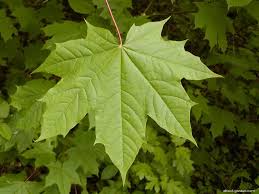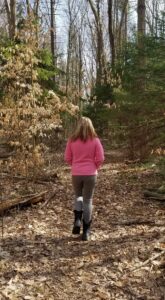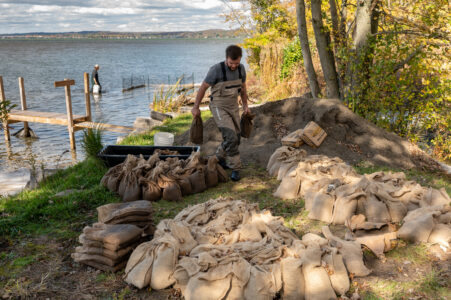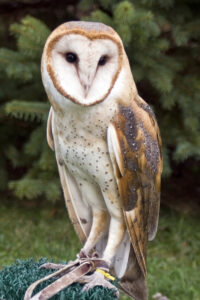Let’s Talk About Trees

Image of a leaf from a Norway Maple tree, one the most common invasive trees in Western New York. Photo courtesy WNY PRISM
This might be a little controversial, but it’s been on my mind for a while. I was recently sitting in my backyard with my friend Mackenzie beneath the coverage of the 200+ trees that surround my home. We started talking about invasive trees, and I found myself asking her a question I’ve been wondering about for some time:
What if we were to intentionally keep some non-native trees, or even some invasive ones?
We all know invasive species are a problem. Invasive plants, invasive fish, invasive insects – our ecosystems are full of them. At the Chautauqua Watershed Conservancy, we talk about invasives often. We host invasive species workshops, coordinate invasive aquatic plant removals, and have a conservationist, Carol Markham, who visits homes and businesses through our YardSmarts program to help property owners identify opportunities for planting natives and managing invasives.
We’ve spearheaded initiatives for the large-scale removal of invasive trees, like the program we ran with high school students to remove Tree-of-Heaven in Jamestown. So, why am I suggesting we might keep some? That doesn’t sound right – and I hear you. But before you dismiss the idea, let’s take a closer look at what we’re really facing.
Here are four of the most common invasive trees in our area (though there are certainly more):
≤ Norway Maple (Acer platanoides) – Popular as a hardy street tree but notorious for escaping cultivation. It grows in poor soil, tolerates pollution, and completely displaces native maples and other trees.
≤ Tree-of-Heaven (Ailanthus altissima) – A fast-growing, toxin-producing tree that forms dense thickets and destroys sidewalks, sewers, and foundations with its roots.
≤ White Poplar (Populus alba) – Form large single-species colonies, suppressing the growth of native trees, shrubs, and grasses by creating thick shade and blocking access to soil nutrients and water. These trees also cause a lot of physical damage to structures and harm the movement of stormwater because of their large shallow root systems.
≤ Black Locust (Robinia pseudoacacia) – Native to the southeastern U.S. but invasive here. It shades out other plants and reproduces aggressively through its roots.
We know these trees are problematic. They cause biodiversity loss, alter soil chemistry, and disrupt native ecosystems. And yet, removing them isn’t always simple or always the right move.
So, when is removing any tree the best environmental choice? Cutting down any type of tree can feel wrong, but sometimes it’s necessary. Other times, it might do more harm than good, especially if no one is there to replant or restore the habitat that tree once provided.
Here’s one way to think about it in a kind of hierarchy for your decision making:
1. Best: Remove invasive trees and replace them with native trees or shrubs. This restores the ecosystem and prevents invasives from taking back over.
2. Next Best: If you can’t replant right away, at least manage what you remove. Control regrowth by cutting new shoots, monitoring seedlings, and preventing seed spread.
3. Okay, but Hopefully Temporary: Keep some non-native trees if they provide important benefits like shade, erosion control, wildlife habitat, and carbon sequestration, until you can replace them with native species.
4. Avoid: Clear-cutting invasives and leaving bare soil. This only creates new opportunities for invasives to return faster and stronger.
Our region’s forests have been through massive change. Over the past 250 years, our area has been almost completely timbered, much of it to supply the furniture industry that was robust in our area. Some replanting followed, but often as monocultures. Now, climate change and new pests are threatening many of the native trees we depend on. Ash trees have been decimated by the emerald ash borer. Beech trees are falling to beech leaf disease. And a new pest, the redbay ambrosia beetle, is threatening our sassafras trees. Add to that frequent storms, strong winds, and drastic weather that’s not “normal for here,” and it’s easy to see why our forests are struggling. We are losing native trees faster than we can replace them.
So, what do we do? I’m not suggesting we stop promoting and planting native trees – far from it. Native plants are the foundation of our ecosystems. They support native insects, and those insects feed our birds and wildlife. But maybe there’s room for a little nuance. Maybe some fast-growing, hardy, or pest-resistant non-native trees can play a short-term role in providing shade, soil stability, carbon sequestration, and habitat while we plan for longer-term restoration. Because having trees, even imperfect ones, is better than having no trees at all.
Chautauqua Watershed Conservancy is a not-for-profit organization with a mission to preserve and enhance the quality, scenic beauty, and ecological health of the Chautauqua region’s lands and waters for our community. For more information, visit chautauquawatershed.org and follow us on Facebook and Instagram.




